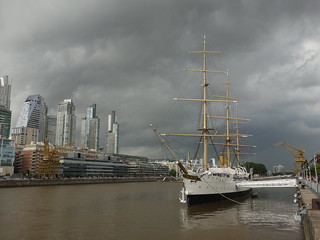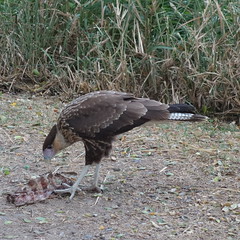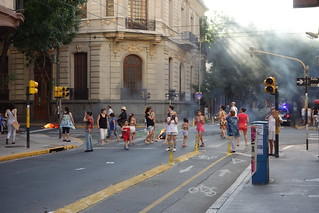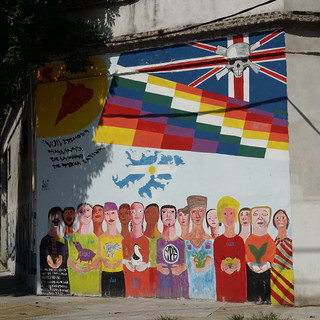Buenos Aires
My first impression was of it immediately feeling a lot more European here than anywhere in Peru or Bolivia. I enjoyed walking around the old ports and in the Costanera Sur nature reserve, incredibly close to the city centre.
This impression was subsequently altered a bit with protestors banging saucepan lids, and burning tyres close to my hostel... And at the same time, a partial power-cut hit the lower floors of the hostel for a night or two. (It wasn't completely clear what the protest was about, but a similar one several blocks away was about lack of electricity and water. But apparently protesting is anyway a common annual event in the summer months, during the holidays and just before Christmas.)
It's over 30 deg Celsius - it's high summer and it really feels like it. There was a bit of a thunder-storm and some drops of rain with the humidity on the first day, however.
Buenos Aires has a complicated relationship with the British. There was a period of close economic ties at the end of the 19th & start of the 20th centuries. The results of this include a large monumental tower - with a conspicuous British coat of arms - prominent in the centre of the square outside the main railway station, and Bar Britanico, from when many British people lived in the city. On the other hand, the Falklands war in the 1980s created a very different sentiment.
On my third day in the city, I suffered an painful but unsuccessful mugging just metres away from the main train and bus stations at Retiro. In broad daylight in what was obviously a rougher street just off the main square, I was confronted by a guy standing there. I assumed he would be looking for money, but he wasn´t satisfied with my wallet and tried to grab my bag. I clung on and was pushed to the ground. I shouted loudly for help and fortunately within seconds, I suppose, someone who seemed to be a security guard of some kind arrived and (I assume) the mugger ran off. Amazingly, he apparently got away with nothing. He left the wallet, and didn´t find my phone (which I assume he was looking for) nor my camera. I was left with an aching left calf muscle and right chest, grazed right knee and elbow, and some swollen patches above and below my left eye... The aching leg was the most worrying - it wasn't painful enough to be fractured, but it wasn't great for my hiking plans. I nevertheless took an overnight bus to Bariloche on Monday 23rd December.
The Museum of Modern Art was great - in a downstairs gallery, a forty-foot equivalent unit was completely wedged on the 3-dimensional diagonal of the room, such that it would be completely impossible to get it in or out or move it, or for it to have got there in the first place... like the sofa in "Dirk Gently's Holistic Detective Agency"...
On the top floor, a project based on collection and documentation of the "Edmondson railway ticket", which was invented in C19 England, but spread throughout the world, was more interesting than you might imagine, starting as a multimedia installation, but veering into live-action, culminating oddly in a gig by a blues-rock 4-piece wearing ticket-collectors' hats.
The currency situation here is very strange - the official exchange rate gets you 8.5 pesos for the Euro, but the more realistic exchange rate, used on the street, is that 1 Euro will buy 11 pesos. If only I had known, I'd have brought along a pile of Euros in cash... as it is I'm stuck with getting the official exchange rate when I go to the ATM.
El Zanjón de Granados, an old house in the San Telmo district opened as a museum, gave a few interesting points to think about. Dating from the 19th century, it was originally only two blocks from the Río de la Plata - where the Avenida Paseo Colón is now - which has since been pushed back. Underneath the house, the junction of two streams heading towards the river has been vaulted over. A large cistern collected rain-water for the original family occupiers - and they kept tortoises in it to clean it, an intriguing technique.
"Cambio Cambio Cambio" say the multitudes of individuals hanging around on Calle Florida. These are touts representing the black market money changers... It almost seems as if the entire street, which otherwise resembles a normal major high street, is just a front for underground money changing. The police who are stationed at fairly regular intervals ignore all this going on right in front of them... (probably they keep their savings in US dollars in safe deposit boxes too, so are just as interested in keeping this industry in business).
On consulting one of the exchange touts, you're taken to somewhere nearby, probably to a shop in one of the galleries or passageways alongside the street, where you can exchange foreign currency (preferably 100 US dollar bills) for piles of 100 peso notes, at a rate 50% higher than the official exchange rate. If you're lucky, you won't be robbed while off the street, or followed afterwards, and if you're particularly lucky, the notes you get will be genuine...





